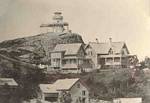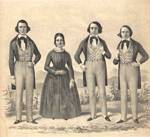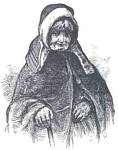Home > Lynn
High Rock
Location, History, and Legends
Location
 Lynn's
High Rock is an outcropping of
porphyry (crystal filled granite) a half a mile from the Atlantic
Ocean, some 200 feet above sea level, the highest elevation
around. The 85-foot high tower and observatory at the top of
High Rock can be easily seen from Lynn City Hall and the downtown
area. The poetry of High Rock is concerned with the view from
High Rock and its elevation. Because High Rock is as close to
heaven as a Lynn poet can get, it inspires divine thoughts in
poets who visit its summit.
Lynn's
High Rock is an outcropping of
porphyry (crystal filled granite) a half a mile from the Atlantic
Ocean, some 200 feet above sea level, the highest elevation
around. The 85-foot high tower and observatory at the top of
High Rock can be easily seen from Lynn City Hall and the downtown
area. The poetry of High Rock is concerned with the view from
High Rock and its elevation. Because High Rock is as close to
heaven as a Lynn poet can get, it inspires divine thoughts in
poets who visit its summit.
To get to High Rock, follow Essex Street away
from downtown Lynn, and turn left up Rockaway Street. Then turn
up High Rock Street and proceed to Circuit Avenue. Park at the
end of Circuit Avenue where High Rock Park, the tower, and the
observatory are located.
History
 Before
English Settlement, High Rock was known to be a Pawtucket Indian
meeting place, and a great chief named Nanapashemet once made
his headquarters there. The modern history of High Rock is the
story of its association with the Hutchinson
Family Singers, who were for several decades America's favorite
singing family. Family leader Jesse Hutchinson bought land at
High Rock, and by 1846, he had erected the famous Stone Cottage
for his family. Other cottages were added, as well as a tower
at the summit. During the Civil War, the family held concerts
at High Rock. The Hutchinsons were committed to progressive
causes, and these included abolition, women's rights, and worker's
rights. This commitment is expressed in the lyrics to the family's
song, "High Rock":
Before
English Settlement, High Rock was known to be a Pawtucket Indian
meeting place, and a great chief named Nanapashemet once made
his headquarters there. The modern history of High Rock is the
story of its association with the Hutchinson
Family Singers, who were for several decades America's favorite
singing family. Family leader Jesse Hutchinson bought land at
High Rock, and by 1846, he had erected the famous Stone Cottage
for his family. Other cottages were added, as well as a tower
at the summit. During the Civil War, the family held concerts
at High Rock. The Hutchinsons were committed to progressive
causes, and these included abolition, women's rights, and worker's
rights. This commitment is expressed in the lyrics to the family's
song, "High Rock":
| |
In the State of Massachusetts,
In the good old town of Lynn,
There's a famous range of ledges,
As eye hath ever seen;
Two hundred feet the highest point
Looms up this rugged block,
And it's known throughout New England
As "Old High Rock."
And here the tribe of Jesse
Sang and made the people talk
Of the friends of right and progress,
At "Old High Rock." |
In 1904, in response to a civic movement to acquire
High Rock for the city, aging family leader John
W. Hutchinson gave the family land, including the summit,
to Lynn. In return, the city agreed to build a tower to
replace the first tower, which had accidentally burned during
a celebration of the Civil War's end in 1865. The
tower and its astronomical observatory were completed
in 1906. Since then, periodic improvements have led to
the recently completed total renovation of the observatory
and its telescope by Lynn Community Development. Visit
the city of Lynn's website for more information about observatory
activities and the history
of High Rock.
The inspirational nature of High Rock is well illustrated by one interesting moment in its history. In 1853, the Hutchinson family gave former Universalist minister and then obsessive spiritualist John Murray Spear permission to use their woodshed while he worked on constructing an electrical machine that would revolutionize life and be a New Messiah. Spear believed he could channel messages from dead spirits, and when the "Band of Electricizers," as he called them, spoke to him, they instructed him to build such a machine at High Rock. They also told him exactly how to build it. The crowning moment of the God Machine, as some came to call it, came in June 1854, when, with the machine completed, and about the size of a dishwasher, a pregnant woman, known only as New Mary, lay down in front of it while in labor. When she got up and touched the machine, Spear claims it moved, animated by what he called New Motive Power. Naturally, the claim proved controversial, but in retrospect, Spear's experiment at High Rock shows a pre-Civil War fascination with electricity and underscores the character of High Rock as a source of inspiration and spiritual energy.
Legends
 The
most legendary High Rock resident was Moll Pitcher, a clairvoyant
who lived on Essex Street at the base of High Rock for fifty
years until she died in 1813. Many sailors whose fortunes she
foretold spread word of Moll Pitcher up and down the New England
coast. Moll Pitcher's legendary status was sealed when the great
American poet John
Greenleaf Whittier (www.whittierpoetry.org), a resident of Amesbury, published his
first epic poem, "Moll Pitcher" in 1831.
The
most legendary High Rock resident was Moll Pitcher, a clairvoyant
who lived on Essex Street at the base of High Rock for fifty
years until she died in 1813. Many sailors whose fortunes she
foretold spread word of Moll Pitcher up and down the New England
coast. Moll Pitcher's legendary status was sealed when the great
American poet John
Greenleaf Whittier (www.whittierpoetry.org), a resident of Amesbury, published his
first epic poem, "Moll Pitcher" in 1831.  Unfortunately,
in the poem, Whittier is unkind to his subject. In Whittier's
poem, Moll Pitcher incorrectly predicts a sailor's death, and
upon his safe return, she is discredited and dies a miserable
death. Later in his life, Whittier grew to dislike the poem,
perhaps because of its unsympathetic portrayal of Moll Pitcher's
appearance and her life. Consider these excerpts:
Unfortunately,
in the poem, Whittier is unkind to his subject. In Whittier's
poem, Moll Pitcher incorrectly predicts a sailor's death, and
upon his safe return, she is discredited and dies a miserable
death. Later in his life, Whittier grew to dislike the poem,
perhaps because of its unsympathetic portrayal of Moll Pitcher's
appearance and her life. Consider these excerpts:
| |
She stood upon a bare tall crag
Which overlooked her rugged cot-
A wasted, gray, and meagre hag,
In featured evil as her lot.
She had the crooked nose of a witch,
And a crooked back and chin;
And in her gait she had a hitch,
And in her hand she carried a switch,
To aid her work of sin,
A twig of wizard hazel, which
Had grown beside a haunting ditch,
Where a mother her nameless babe had thrown
To the running water and merciless stone.
....
Even she, our own weird heroine,
Sole Pythoness of ancient Lynn,
Sleeps calmly where the living laid her;
And the wide realm of sorcery,
Left by its latest mistress free,
Hath found no gray and skilled invader.
.... |
from: New England Legends and Folklore by Samuel Francis
Drake
(Boston: Little, Brown) 1902.
Learn more about Whittier's influence on Lynn's poetry




